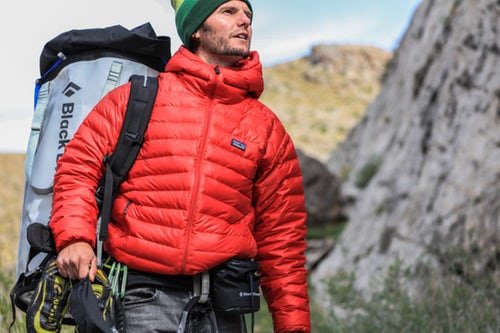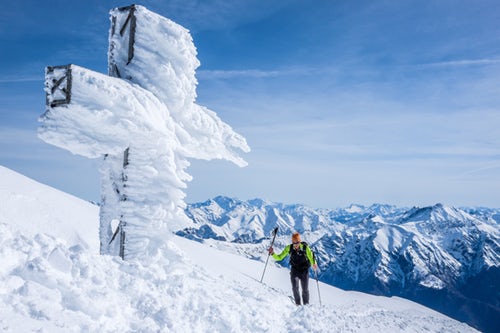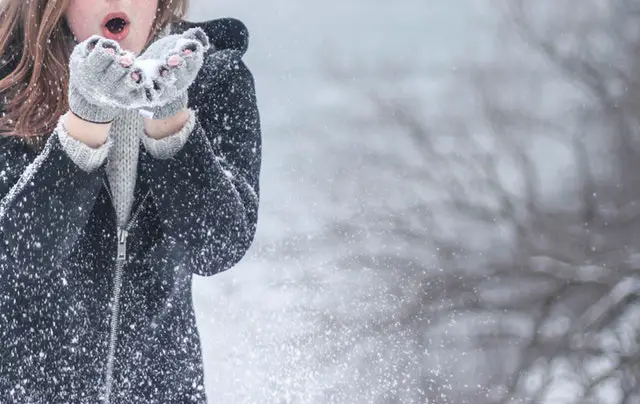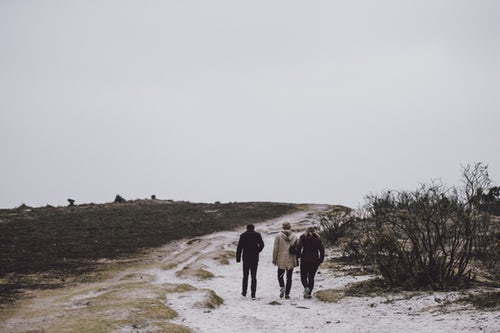Winter Hiking: How to Stay Safe and Warm
 Winter Hiking: How to Stay Safe and Warm
thegearhunt.com
Winter Hiking: How to Stay Safe and Warm
thegearhunt.com
It doesn’t need to be the absolute middle of the winter for cold weather to be something that should be a concern on your trips hiking. Depending on where you are hiking and where you live, you might encounter temperatures that are cold during any time of the year, and that can make hiking something that is uncomfortable, and even worse, it might cause an illness or injury.
If you want your hiking adventures to be more pleasant, you should arm yourself with some knowledge and a few tips for hiking in the cold weather.

Gear and Clothing Tips
If you want to remain comfortable on your hikes in the cold weather, the key is to carry all of the right gear and to wear the right kinds of clothes.
Wear layers. Layering up is a system of three parts. It should include a base layer that will wick moisture away from you, a middle layer that will keep you insulated from the cold, and a top layer that will keep moisture and wind out. The end goal with this process is to be able to remove or add layers during your hike so that you will be able to remain comfortable and warm while not getting sweaty or overheating. It might be a pain to have to stop and alter your clothing, but it is critical that you remain dry. If you get wet on cold days, you have a larger chance of suffering from hypothermia.

No cotton. When you are wearing cotton and it gets wet, you may have noticed that it can take quite a while to dry. This can leave you cold, damp, and just plain miserable. Wool and synthetic layers will dry much faster while also moving sweat away from your skin.
Skin needs covering. Any of your skin that remains exposed to cold wind and freezing temps will be prone to frostbite. You need to pay special attention to your toes, fingers, ears, cheeks, and nose.
Hands. You should always try to wear mid- or light weight fleece gloves and then cover those with waterproof mittens or gloves. It can also be a good idea to bring along extra pairs of fleece gloves in your backpack in case the fleece gloves you have on get wet.
Feet. You should be wearing wool or synthetic socks that are well fitting. The thicker the sock, the more insulation you get. However, you also need to ensure that they don’t make whatever footwear you will be wearing too tight. If your shoes/boots fit too tightly, they can cut the circulation to your feet off. You also need to remember how important it is to make sure that your feet remain dry. This means that carrying a couple of extra pairs of socks is just common sense. The shoes or boots you wear should be waterproof and insulated.
Cheeks and nose. You can always use a gaiter as a face mask to keep your cheeks and nose warm.
Ears. To keep your ears warm, you can go with a headband or a winter hat. A face mask or gaiter can also help with this.
No tight clothes. Boots and gaiters, the cuffs of gloves, the bands of wristwatches that are on too tightly can lead to poor circulation. This can increase the chances of you getting frostbitten. Ensure that all of your gear and clothing fit properly.
Add a bit of heat. Toe and hand warmer packs are a fantastic way to keep your digits warm, this works especially well if you tend to suffer more  than others from cold toes and fingers.
than others from cold toes and fingers.
Wear a hat. We all lose heat right through the top of our head. This means that if you are a bit chilly, you need to be wearing a hat.
Use gaiters. If you will be hiking through areas of deep snow, gaiters are great for keeping the cold, wet stuff out of your boots. They can also add just a bit of warmth. If you are going to do this, make sure that you use breathable/waterproof gaiters that are meant for hiking in the snow.
Sunglasses and/or goggles. You should always strive to keep your eyes protected from the wind and snow. Many types of goggles and even some sunglasses are made so that you can trade out the lenses, which enables you to get just the right tint for wearing them in the winter.
Headlamps. When you are hiking in cold weather, you will have fewer hours of daylight, especially when you happen to be in the northern area of the US. This doesn’t always mean that your trip has to end along with the daylight though. However, if you are going to stay out, you will need to be ready to hike in darkness. When you go out, always know when the sun will set and be prepared by packing a headlamp with new batteries.
Keep your batteries warm. Cold weather can mean a quick death for batteries. Alkaline batteries won’t last as long as Lithium batteries, but regardless of the type, it will be your best bet to keep them nice and warm. Stowing things like your cell phone, GPS, headlamp, and any other electronics in pockets close to your body heat will help with this issue.
Sunscreen. Cold weather doesn’t mean that you can’t get a sunburn. In fact, when the ground is covered with snow, the rays of the sun can reflect off of it, which means that you will need to be extra vigilant when it comes to applying sunscreen to places like the skin around your neck and under your chin.
Hydration and Food Tips
 The metabolism of your body will also be its best source of heat. This means that you will need to make sure that it is always fueled with water and food.
The metabolism of your body will also be its best source of heat. This means that you will need to make sure that it is always fueled with water and food.
Eat and drink. Cold weather can mean that you might be less likely to stop your hike just for food and water. You can make this easier by keeping your water and snacks well within your reach so that you will be able to sip and eat with regularity throughout your hike.
Freezing food. I don’t know a single person who enjoys biting down on an energy bar that is as hard as a rock. Foods such as cheese, nuts, chocolate, and candy bars will tend to be softer than other items when the weather is cold. You might need to experiment a bit to determine which foods you will enjoy that can remain edible when the weather is cold. Regardless of what you choose to take on your hikes, keeping the food closer to your body will assist with keeping it thawed and easy to eat.
Freezing drink tubes. If you happen to use a camelback, you will need to keep your drinking tube from freezing if you want to have continuous access to your water. In order to do this, many of the manufacturers of hydrations reservoirs make items that will insulate both the bite valve and the tube itself. Also, more than a few handy hikers have been able to create their own insulation for these things using inexpensive foam from their local hardware store.
Water bottles. In temps that are very cold, you might need to forget about your hydration reservoir and use bottles for your water. This is when the chances of your drinking tube freezing are quite high. However, bottles can also freeze, and it typically happens starting from the top and working its way down to the bottom. This means that the first part of your bottle that will freeze will be the cap, and this could effectively prevent you from opening it. This problem is solved easily by simply flipping the bottle upside down. Also, keeping your water bottles in your pack as opposed to in their exterior pockets will keep them insulated from the temps.
You might also buy sleeves that are insulated for your water bottles.
Warm drinks. Fill an insulated bottle with something like hot chocolate or hot tea so that you can sip on it whenever you take a break. The warmth will go a long way when it comes to helping you remain comfortable.
Illnesses and Injuries Related to the Cold
 When you decide to go for a hike in cold weather, you will be risking hypothermia and frostbite.
When you decide to go for a hike in cold weather, you will be risking hypothermia and frostbite.
Frostbite. This is a condition where your tissues freeze. It commonly happens with ears, toes, and fingers. There are actually 3 different levels of this condition – deep frostbite, superficial frostbite, and frostnip. All 3 versions of this can appear the same when your extremities are frozen, so it might be more than a bit difficult to determine the exact level of frostbite until your skin has been thawed out.
Signs of frostbite:
- Skin is pale, waxy, and cold
- There may be pain or numbness in the area that is affected
- The skin might feel hard if it is frozen or soft if it is partially frozen
- Once your skin has thawed, if you have deep or superficial frostbite, blisters will form.
Frostbite treatment. Frostnip, which is the least dangerous form of this malady, is treated by covering the skin that is affected and taking a bit of time to warm it back up. Things like placing cold toes on the warm belly of your partner or placing your frozen fingertips in your armpit are good ways to do this. Never rub the cold skin or put it under hot water because at this point, the tissue is quite susceptible to being damaged.
If treating the frostnip results in blistering, then your frozen extremities are worse than simple frostnip. It is best to head to the nearest medical facility for treatment in this case. As with the frostnip, don’t put the frozen extremities under hot water and don’t rub the area that is affected. Once it has thawed out, you need to be vigilant about letting it freeze again.
Hypothermia. This is what happens when your core body temperature drops below what it should be. Some people think this only occurs in the winter, but cold rain or falling into cold water can also cause this malady. This is a condition that is life-threatening, and it needs to be taken very seriously.
Symptoms of mild hypothermia:
- Change in mood, confusion, slow thinking
- Minor clumsiness, such as trouble with zippers
- Shivering
Symptoms of moderate hypothermia:
- Obvious alteration of mental status, such as forgetfulness or irritability
- Obvious alteration of coordination, such as stumbling and/or falling
- Shivering that is intense
Symptoms of severe hypothermia:
- Pulse might not be detectable
- Mental status that is deteriorating, such as irrational behavior or disorientation
- Shivering might cease because of the depletion of energy
 Hypothermia treatment. When it comes to treating hypothermia, the firs thing you need to do is to change the environment of the person suffering. This means that you need to get them inside as soon as possible. If you don’t happen to be anywhere near shelter, you have to do what is necessary to get the person suffering from hypothermia away from the cold, like getting them off the snow and out of the wind. If the clothing they are wearing is wet, get them out of it and into dry clothes. Ensure that they are well insulated. Give them food and water so that they will have the energy to shiver, which is the body’s way to naturally produce a bit of heat.
Hypothermia treatment. When it comes to treating hypothermia, the firs thing you need to do is to change the environment of the person suffering. This means that you need to get them inside as soon as possible. If you don’t happen to be anywhere near shelter, you have to do what is necessary to get the person suffering from hypothermia away from the cold, like getting them off the snow and out of the wind. If the clothing they are wearing is wet, get them out of it and into dry clothes. Ensure that they are well insulated. Give them food and water so that they will have the energy to shiver, which is the body’s way to naturally produce a bit of heat.
With treatment that is both timely and proper, hikers suffering from mild hypothermia will possibly be able to recover and finish the trip. Hikers suffering from moderate to severe hypothermia will need to receive medical treatment as soon as they can be evacuated or rescued by first responders.
By following the tips and advice you got here today, you should be able to safely and comfortably hike regardless of how cold it might be.
Sources
- You Tube, Safety Tips for Winter Hiking
- Hit the Trail, Winter Hiking Tips
- Yukon Charlies, Six Basic Safety Tips for Hiking in Winter (or Any Time of the Year)
- Hiking for Her, Winter Hiking Tips















